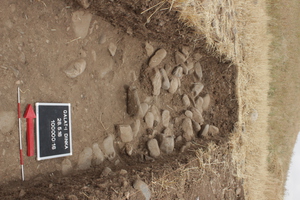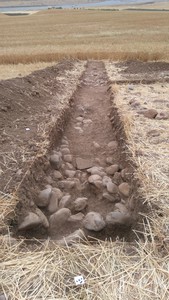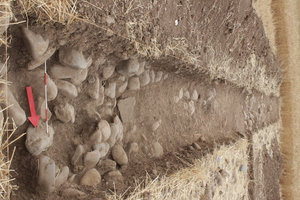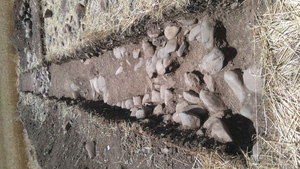Locus:100000:016
Wall: stone wall in eastern trench
Administration
| Beginning | 29.05.2016 |
| Ending | |
| Liters | 21000 |
Description of the Locus
| General Description |
Wall in the west the stones are well alligned forming a line, in the east it is more irregular. Stones are large and can reach about 30 cm of width. Some charcoal particles have been found. At the end of excavation we found out that wall 16 and 18 are the same large wall which is under number 16. Final description: Wall L:100000:016 is 1.10 m wide, on the N and the S edges of the wall there are large stones reaching a length of 40 cm and height up to 20 cm. In between large stones there are smaller ones. The wall is oriented EEN to WWS. It starts in the E baulk, maybe there is a corner under the E section as a very large stone is here visible. The wall on the W edge is not very clear because it was cut by the looting pit . The wall has a total lenght of 6 m. On the W edge the lowest course is visible and it rests on the small pebble locus L:100000:026. The wall has 5 courses of stones preserved in height. It is destroyed by two looting pits, L:100000:013 and L:100000:012. To the N of the wall there is a trodden mud floor (L:100000:031). With Gird-i Bazar-type pottery resting on it. the floor slopes down towards the west with steps. One step is preserved (locus 33) with 4 flat stones set at the edge of the step. The next step is lost. The arragement of stones of wall L:100000:016 indicates there was another step. Towards the west, wall L:100000:016 is cut by the looting pit L:100000:07. |
| Boundaries (Contrast, Topography) | It is located in the eastern trench and it continues into the S section. |
| Consistency (Components, Colours) | big stones at the edges (length 30 cm , hight 15 cm), smalller stones inbetween |
| Interpretation & Classification of the Locus | wall of main occupation |
Collections
Singlefinds






